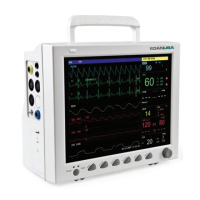Patient Monitor User Manual Monitoring ECG/ RESP
- 95 -
Chapter 13 Monitoring ECG/RESP
13.1 Overview
Monitoring the ECG produces a continuous waveform of the patient's cardiac electric activity to
enable an accurate assessment of his current physiological state. Only proper connection of the
ECG cables can ensure satisfactory measurement. On the Normal Display, the monitor provides
display of 2-channel ECG waveforms.
The patient cable consists of 2 parts
The cable connects to the monitor
The lead set connects to the patient
Use a 3-lead or 5-lead set to monitor the ECG.
The monitor displays the Heart Rate (HR), ST segment and Arrhythmia analysis.
All of the parameters above can be set as alarm parameters.
Lead off detecting: detect all the electrodes, indicate the broken off leads.
Anti-electrotome function: if the monitor works with high-frequency electrotome, it will not
be deadlock or restarting.
Every ECG channel has Pacing impulse rejection and Bandpass filter circuit.
Defibrillation protection (needs 1K resistance ECG cables in series) and hardware clamp
function.
NOTE:
1 In the default settings of the monitor, the ECG waveforms are the first two waveforms
from top in the Waveform Area.
2 The defibrillator cables should be used in the ECG monitoring that can prevent the
cables from being burned by high frequency.
13.2 ECG Safety Information
WARNING
1 Do not come into contact with the patient, table, and the monitor during defibrillation.
2 Only use the ECG leads supplied by the manufacturer when using the monitor for
ECG monitoring.
3 When connecting the cables and electrodes, make sure no conductive part is in
contact with the ground. Verify that all ECG electrodes, including neutral electrodes,
are securely attached to the patient but not the conductive part or ground.
4 The electrodes should be made of the same metal materials.

